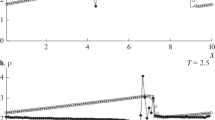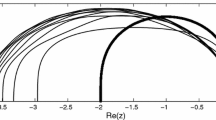Abstract
A simple factorization of the finite-dimensional Galerkin operators motivates a study of the numerical stability of a Galerkin procedure on the basis of its “potential stability” and the “conditioning” of its coordinate functions. Conditions sufficient for stability and conditions leading to instability are thereby identified. Numerical examples of stability and instability occurring in the application of the Galerkin method to boundary-integral equations arising in simple scattering problems are provided and discussed within this framework. Numerical instabilities reported by other authors are examined and explained from the same point of view.
Similar content being viewed by others
References
K.E. Atkinson, The Numerical Solution of Integral Equations of the Second Kind(Cambridge University Press, Cambridge, 1997).
J.-P. Aubin, Approximation of Elliptic Boundary-Value Problems(Wiley-Interscience, New York, 1972).
D. Braess, Finite Elements(Cambridge University Press, Cambridge, 1997), English translation of Finite Elemente(Springer, 1992), translated by L.L. Schumaker.
A.G. Dallas, On a boundary-data operator and generalized exterior Robin problems for the Helmholtz equation, NRL Report 9008, Naval Research Laboratory, Washington, DC (1987).
J.J. Dongarra, C.B. Moler, J.R. Bunch and G.W. Stewart, LINPACK Users' Guide(SIAM, Philadelphia, PA, 1979).
J. Giroire, Integral equation methods for exterior problems for the Helmholtz equation, Rapport Interne No. 40, Centre de Mathématiques Appliquées, Ecole Polytechnique, Palaiseau, France (1978).
S. Hildebrandt and E. Wienholtz, Constructive proofs of representation theorems in separable Hilbert space, Comm. Pure Appl. Math. 17 (1964) 369-373.
G.C. Hsiao and R.E. Kleinman, Error analysis in numerical solution of acoustic integral equations, Internat. J. Numer. Methods Engrg. 37 (1994) 2921-2933.
G.C. Hsiao and W.L. Wendland, A finite element method for some integral equations of the first kind, J. Math. Anal. Appl. 58 (1977) 449-481.
G.C. Hsiao and W.L. Wendland, The Aubin-Nitsche lemma for integral equations, J. Integral Equations 3 (1981) 299-315.
M.A. Krasnosel'ski(ie67-01), G.M. Vainikko, P.P. Zabreiko, Y.B. Rutitski(ie67-02) and V.Y. Stetsenko, Approximate Solutions of Operator Equations(Wolters-Noordhoff, Groningen, 1972).
N. Limić, Galerkin-Petrov method for Helmholtz equation exterior problems, Glasnik Matematički 16 (1981) 245-260.
J.T. Marti, Introduction to Sobolev Spaces and Finite Element Solution of Elliptic Boundary Value Problems(Academic Press, London, 1986).
J.-C. Nedelec and J. Planchard, Une méthode variationnelle d'éléments finis pour la résolution numérique d'un problème extérieur dans R 3, RAIRO 7 R3 (1973) 105-129.
W.L. Wendland, Boundary element methods and their asymptotic convergence, in: Theoretical Acoustics and Numerical Techniques, ed. P. Filippi (Springer, Wien, 1983) pp. 135-216.
W.L. Wendland, Private communication.
Author information
Authors and Affiliations
Rights and permissions
About this article
Cite this article
Dallas, A.G., Hsiao, G. & Kleinman, R. Observations on the numerical stability of the Galerkin method. Advances in Computational Mathematics 9, 37–67 (1998). https://doi.org/10.1023/A:1018941607627
Issue Date:
DOI: https://doi.org/10.1023/A:1018941607627




